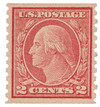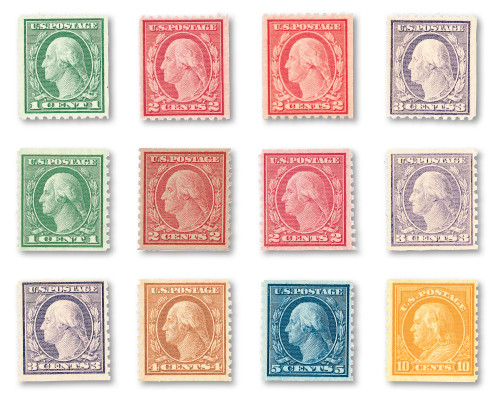
1916 2c Washington, carmine, vertical perf 10, type II
# 491 - 1916 2c Washington, carmine, vertical perf 10, type II
$695.00 - $9,900.00
U.S. #491
1916-22 2¢ Washington
Type II
1916-22 2¢ Washington
Type II
Issue Date: November 17, 1916
Printed by: Bureau of Engraving and Printing
Printing Method: Rotary Press
Watermark: None
Perforation: 10 vertically
Color: Carmine
Fewer than 300,000 U.S. #491 stamps are estimated to have been issued. Scarce U.S. #491 is often confused with U.S. #454. It’s easy for collectors to miss the single watermarks in U.S. #454 that are often faint or hard to make out, so they are sometimes mistaken for unwatermarked U.S. #491.
The BEP switched to unwatermarked paper in 1916 in a move to save money. U.S. aid to Europe during World War I, as well as the country’s expected entry into the war, made such cost-cutting moves practical.
Type II
Some of the features of the Type II Rotary Press Washington stamps are: the left ribbon has only one line on the top fold (Type III has two); the strand of hair between the ear and cheek has a pronounced, curved outline on the bottom; the shaded area above Washington’s eye pushes upwards; a line on the right-hand ribbon appears as three dashes; shading lines in his hair, and in the laurel leaves, are often more pronounced than in Type I stamps, but less pronounced than Type III.
Mail During World War I
One of the major problems for the U.S. during World War I was the establishment of mail service to the American Expeditionary Forces (AEF) in France. Shortly after the United States declared war on Germany, it became necessary to organize a postal system for the American troops overseas. On June 13, 1917, Postmaster General Albert Burnham authorized the establishment of mail agencies in France. Marcus Bunn, assistant superintendent of the Railway Mail Service, was appointed as Postal Agent in Charge. Soon after his arrival in Paris on June 30th, he began making arrangements for “The United States Mail Agency in France.”
Meanwhile, back home, a distribution center was established at the Chelsea Terminal in New York City. Here, all outgoing mail was processed and then forwarded to Hoboken Port of Embarkation. On the other side of the ocean, centers were organized to receive incoming mail and distribute it to the soldiers.
Troops began arriving in France as early as June 14, 1917, but the first mail agency was not set up until nearly a month later. An official bulletin relates the tale. As the first troops of the American Expeditionary Force were preparing to leave the Port of Arrival, General Pershing inquired of the United States Postal Agent, “How soon can postal facilities be provided?”
Bunn replied, “I can leave by the first train, after two hours.”
Pershing then asked, “I mean how soon can you have working force there?”
“I shall take my force with me,” was Bunn’s answer.
Two hours and twenty minutes later, Bunn and his three men boarded a train and arrived at the campsite within an hour. An empty building was located and extra supplies, such as packing boxes and distribution cases were set up to hold the mail. The first U.S. Army Post Office (APO), APO Number 1, was established in St. Nazaire, and APO Number 2 followed shortly thereafter in Paris.
U.S. #491
1916-22 2¢ Washington
Type II
1916-22 2¢ Washington
Type II
Issue Date: November 17, 1916
Printed by: Bureau of Engraving and Printing
Printing Method: Rotary Press
Watermark: None
Perforation: 10 vertically
Color: Carmine
Fewer than 300,000 U.S. #491 stamps are estimated to have been issued. Scarce U.S. #491 is often confused with U.S. #454. It’s easy for collectors to miss the single watermarks in U.S. #454 that are often faint or hard to make out, so they are sometimes mistaken for unwatermarked U.S. #491.
The BEP switched to unwatermarked paper in 1916 in a move to save money. U.S. aid to Europe during World War I, as well as the country’s expected entry into the war, made such cost-cutting moves practical.
Type II
Some of the features of the Type II Rotary Press Washington stamps are: the left ribbon has only one line on the top fold (Type III has two); the strand of hair between the ear and cheek has a pronounced, curved outline on the bottom; the shaded area above Washington’s eye pushes upwards; a line on the right-hand ribbon appears as three dashes; shading lines in his hair, and in the laurel leaves, are often more pronounced than in Type I stamps, but less pronounced than Type III.
Mail During World War I
One of the major problems for the U.S. during World War I was the establishment of mail service to the American Expeditionary Forces (AEF) in France. Shortly after the United States declared war on Germany, it became necessary to organize a postal system for the American troops overseas. On June 13, 1917, Postmaster General Albert Burnham authorized the establishment of mail agencies in France. Marcus Bunn, assistant superintendent of the Railway Mail Service, was appointed as Postal Agent in Charge. Soon after his arrival in Paris on June 30th, he began making arrangements for “The United States Mail Agency in France.”
Meanwhile, back home, a distribution center was established at the Chelsea Terminal in New York City. Here, all outgoing mail was processed and then forwarded to Hoboken Port of Embarkation. On the other side of the ocean, centers were organized to receive incoming mail and distribute it to the soldiers.
Troops began arriving in France as early as June 14, 1917, but the first mail agency was not set up until nearly a month later. An official bulletin relates the tale. As the first troops of the American Expeditionary Force were preparing to leave the Port of Arrival, General Pershing inquired of the United States Postal Agent, “How soon can postal facilities be provided?”
Bunn replied, “I can leave by the first train, after two hours.”
Pershing then asked, “I mean how soon can you have working force there?”
“I shall take my force with me,” was Bunn’s answer.
Two hours and twenty minutes later, Bunn and his three men boarded a train and arrived at the campsite within an hour. An empty building was located and extra supplies, such as packing boxes and distribution cases were set up to hold the mail. The first U.S. Army Post Office (APO), APO Number 1, was established in St. Nazaire, and APO Number 2 followed shortly thereafter in Paris.














